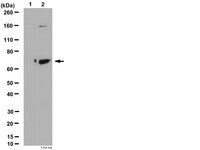06-1303 Sigma-AldrichAnti-phospho-ZAP-70 (Tyr493) Antibody
Anti-phospho-ZAP-70 (Tyr493) Antibody is an antibody against phospho-ZAP-70 (Tyr493) for use in WB.
More>> Anti-phospho-ZAP-70 (Tyr493) Antibody is an antibody against phospho-ZAP-70 (Tyr493) for use in WB. Less<<Recommended Products
Overview
| Replacement Information |
|---|
Key Specifications Table
| Species Reactivity | Key Applications | Host | Format | Antibody Type |
|---|---|---|---|---|
| H, M, R | WB | Rb | Affinity Purified | Polyclonal Antibody |
| References |
|---|
| Applications | |
|---|---|
| Application | Anti-phospho-ZAP-70 (Tyr493) Antibody is an antibody against phospho-ZAP-70 (Tyr493) for use in WB. |
| Key Applications |
|
| Physicochemical Information |
|---|
| Dimensions |
|---|
| Materials Information |
|---|
| Toxicological Information |
|---|
| Safety Information according to GHS |
|---|
| Safety Information |
|---|
| Storage and Shipping Information | |
|---|---|
| Storage Conditions | Stable at 2-8°C for 1 year from date of receipt. |
| Packaging Information | |
|---|---|
| Material Size | 100 µg |
| Transport Information |
|---|
| Supplemental Information |
|---|
| Specifications |
|---|
| Global Trade Item Number | |
|---|---|
| Catalog Number | GTIN |
| 06-1303 | 04053252282843 |
Documentation
Anti-phospho-ZAP-70 (Tyr493) Antibody Certificates of Analysis
| Title | Lot Number |
|---|---|
| Anti-phospho-ZAP-70 (Tyr493) - NG1630776 | NG1630776 |







